







Guantánamo, Cuba: A Journey Through Culture and Flavor
My second visit to Cuba, but my first time in Guantánamo, was an experience unlike any other. Traveling in November 2024, I was eager to explore this lesser-known part of the country, far from the bustling streets of Havana or the tourist-packed beaches of Varadero. What I found was a city rich in history, culture, and a unique blend of influences that made every moment memorable.
A Different Side of Cuba
Guantánamo, often overshadowed by its infamous naval base, is a city brimming with life and authenticity. Walking through its streets, I was captivated by the Afro-Cuban rhythms that filled the air, a reflection of the region’s strong Caribbean influences. Unlike other Cuban cities, Guantánamo has a distinct character, with elements of Haitian, Jamaican, and French heritage woven into its culture.
Culinary Delights
As someone who appreciates the deep connection between history and food, I was thrilled to explore Guantánamo’s cuisine. The highlight? Cucurucho—a delicious mix of coconut, honey, and tropical fruits wrapped in palm leaves. It was a perfect representation of the city: simple, sweet, and full of tropical flavors. The seafood was also unforgettable, with freshly caught fish seasoned with local spices that carried a hint of the island’s diverse culinary history.
Music and Culture
No trip to Guantánamo is complete without experiencing changüí, a music genre that predates son cubano and is deeply rooted in the region. The raw energy of the music, paired with spontaneous dancing in the streets, gave me a true taste of Cuba’s soul. Visiting Casa del Changüí was a personal highlight, where I met passionate musicians dedicated to preserving this traditional sound.
A Visit to El Zoológico de Piedra
One of the most unexpected yet fascinating places I visited was El Zoológico de Piedra (The Stone Zoo). Nestled in the hills outside Guantánamo, this open-air museum is a masterpiece of art and nature. It features hundreds of animal sculptures carved directly into limestone by Cuban artist Ángel Íñigo Blanco. Walking among these life-sized stone creatures—lions, elephants, crocodiles, and even dinosaurs—felt surreal, as if the entire landscape had been transformed into a frozen wildlife scene. The sheer creativity and effort behind this site made it one of the most unique experiences of my trip.
Experiencing Estadio Nguyen Van Troi
As a sports fan, I couldn’t miss the chance to visit Estadio Nguyen Van Troi, the home stadium of Guantánamo’s baseball team. Baseball is a passion in Cuba, and even though I didn’t get to see a live game, just standing in the stadium and feeling the atmosphere was exciting. The stadium, named after a Vietnamese revolutionary, has a special place in the city’s identity, and the pride of local fans was evident in every conversation I had. If I ever return, I’d love to experience the energy of a live game here.
The Journey That Wasn’t
One of my biggest disappointments on this trip was having to cancel my visit to Baracoa. I had been looking forward to experiencing Cuba’s oldest city, but unfortunately, hurricanes had destroyed the roads at San Antonio de Sur, making the journey impossible. It was a reminder of how vulnerable these regions can be to nature’s forces and how travel plans sometimes have to adapt.
A Journey Worth Taking
Despite the setback, Guantánamo offered a unique perspective on Cuba, one that is often overlooked but incredibly rewarding to explore. From its warm and welcoming people to its vibrant music, unforgettable flavors, fascinating stone-carved zoo, and even the passion for baseball, the city left an imprint on me that I won’t soon forget.
Would I visit again? Absolutely. There’s still so much more to uncover in this hidden gem of Cuba. And next time, I’ll make sure to reach Baracoa.
